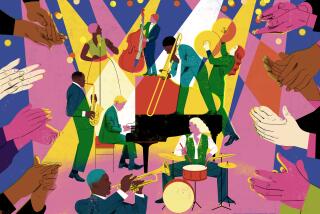The Boisterous Breuker Kollektief Returns for Some Antic Fun
- Share via
The Willem Breuker Kollektief--the Netherlands’ most prominent and often controversial jazz ensemble--was formed 28 years ago. Saxophonist Breuker, a creatively mischievous character, organized an ensemble that managed to embrace many of the iconoclastic notions of ‘60s and ‘70s jazz without falling prey to their frequent tendency to overlook the importance of the performer-audience connection.
On Sunday night at Rocco’s, the Kollektief made its first Los Angeles appearance in more than a decade, performing a late set before an overflow crowd, entertainingly demonstrating a capacity to blend an extraordinary array of differing musical elements. Almost everything seemed grist for the mill: jaunty circus sounds, straight-ahead jazz improvising, wild-eyed free jazz playing, brassy fanfares, warmly harmonized textures, pre-Swing-era jazz styles and much more.
The Kollektief is also well known for the use of theatrical elements reminiscent of ‘60s “happenings” (the predecessors of today’s performance art). Somewhat limited in that area by Rocco’s relatively small stage, the ensemble nonetheless tossed in a few whimsical moments--one, for example, when Breuker pushed aside trumpeter Boy Raamaker (one of the group’s original members) in an effort to gain control of the microphone. After he did so, Breuker--playing soprano saxophone--embarked on a solo encompassing everything from fleet, high-speed note runs to animal cries reminiscent of the Original Dixieland Jazz Band’s “Livery Stable Blues.”
Other solos, especially from Raamaker and trombonists Andy Bruce and Bernard Hunnekink, added a boisterous energy to the musical mix, alternately recalling New Orleans jazz and the vocalized expressions characteristic of early Duke Ellington “jungle” numbers. Ensemble sounds ranged from random, unstructured blowing to crisp, well-orchestrated swinging, often in unusual meters.
Most of the material was original (much of it tracing to the Kollektief’s new album, “Misery”), with the exception of an extremely idiosyncratic rendering of the standard “I Remember April.”
And, although this colorful, musically omnivorous approach might seem to be a recipe for collective chaos, the results were far more compelling--a musical experience fully satisfying the jazz world’s quest for spontaneity and surprise, while also including a warm acknowledgment of the many musical currents, from Europe, Africa and elsewhere, that have been the wellsprings of 20th and 21st century music.
More to Read
The biggest entertainment stories
Get our big stories about Hollywood, film, television, music, arts, culture and more right in your inbox as soon as they publish.
You may occasionally receive promotional content from the Los Angeles Times.










